Though it would seem like a lousy survival technique, many birds we know and love are feathered from head to toe in bright colors. Some of the most beautiful birds are those with bright pink feathers. This article will cover X of these uniquely stunning birds.
10 Pink Bird Species
1. American Flamingo
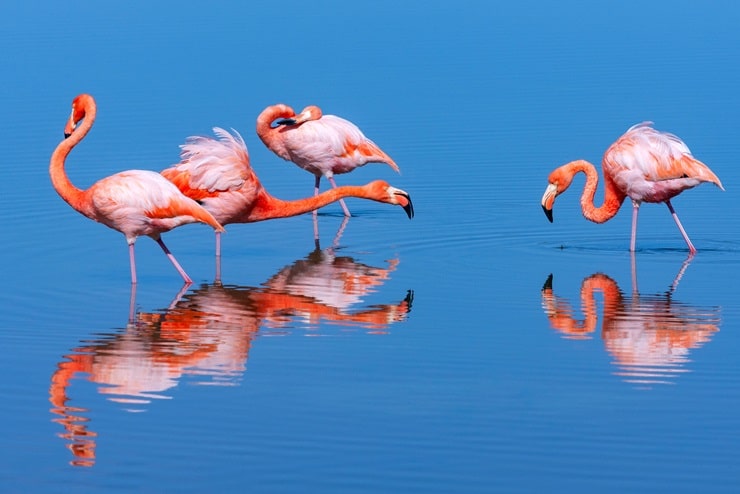
- Scientific Name: Phoenicopterus Ruber
- Size: 47 to 57 inches
- Weight: 4 to 8 pounds
- Wingspan: 55 to60 inches
Though they are born with gray downy feathers, adult American flamingos are known for their bright pink plumage. American flamingos can be distinguished by their thin legs, curved beaks, and long curved necks.
As their name suggests, American flamingos are native to the Americas and can be seen in humid and warm climates such as those found in Florida, the Caribbean, South American countries, and other tropical places around the Americas.
When a pair of American flamingos have mated, they will typically divvy up the duties of constructing and defending the nest but will occasionally do both. It is common for American flamingos to have one brood per year consisting of one clutch.
The pink hue in American flamingo feathers comes from carotenoids in the foods they eat (like shrimp) and are the same things that color tomatoes and fall leaves.
2. Anna’s Hummingbird

- Scientific Name: Calypte Anna
- Size: 3.9 inches
- Weight: 0.1 to 0.2 ounces
- Wingspan: 4.7 inches
With their characteristic straight, thin bills, Anna’s hummingbirds are rather stocky for the type of bird. Males have metallic rose-pink crowns and throats with similar green feathers down their backs, and females have metallic green feathers on their backs and heads with reddish-pink throat feathers.
Native to the western side of North America, Anna’s hummingbirds are found mostly in the western United States with a few in southwest Canada and northwest Mexico. They are not picky birds that will nest in anything ranging from parks to savannahs and even riverside woods.
Anna’s hummingbirds allow the females to build the nest to her liking with things like spider webs and twigs. The female Anna’s hummingbird typically has two clutches per brood with two or three broods per year.
When not viewed in direct sunlight, an Anna’s hummingbird’s iridescent head color may appear more brown or gray than pink.
3. Bourke’s Parakeet (Parrot)
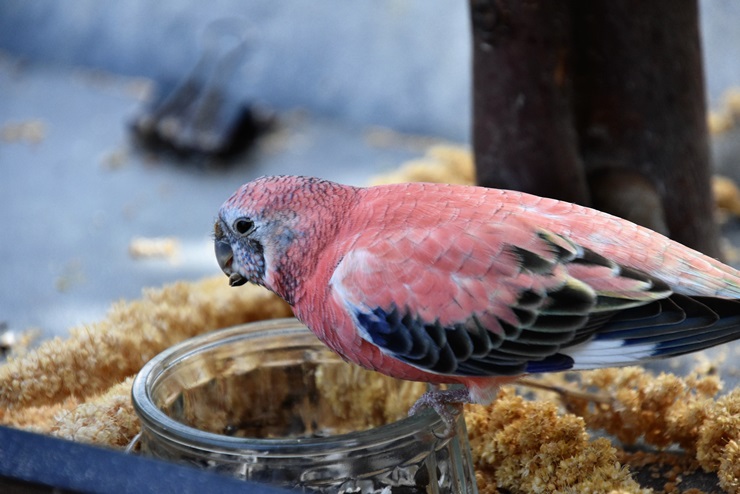
- Scientific Name: Neopsephotus Bourkii
- Size: 7 to 9 inches
- Weight: 1.4 to 1.7 ounces
- Wingspan: 12 inches
Though other parrots and parakeets are rather brightly colored, Bourke’s parakeet is much more subtle. Their backs and heads are covered in dusty brown feathers with pink abdomens and chests as well as blue tail feathers, and males have the same blue on their foreheads.
The Bourke’s parakeet is a nomadic bird species that follows waterways across its native continent of Australia. They have been spotted in Central Australia, northern portions of South Australia, and select areas in Western Australia.
Bourke’s parakeet likes to make its nest in decaying wood that can be found at the bottom of a hollow in a tree. Females have three to six clutches per brood with no more than three broods per year.
Flock sizes of Bourke’s parakeet can reach up to over one hundred birds in one flock.
4. Eurasian Hoopoe
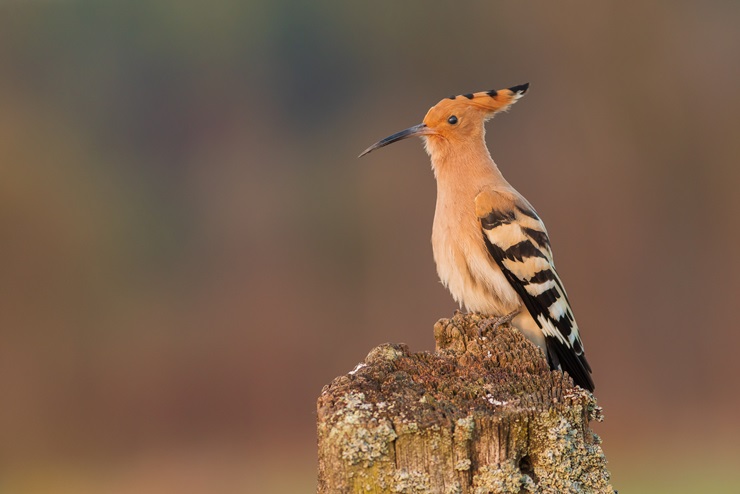
- Scientific Name: Upupa Epops
- Size: 9.8 to 12.6 inches
- Weight: 1.6 to 3.1 ounces
- Wingspan: 17 to 19 inches
The Eurasian hoopoe has a long, slightly curved black bill for digging into the soil to catch insects. The rest of its features are rather striking including their bright pink heads and bodies, zebra-striped wings, and plumes of pink and black feathers on their heads.
As the name suggests, Eurasian hoopoes inhabit most of Europe, portions of Asia, northern Africa, and sub-Saharan Africa. They don’t need many qualifications for their habitat as they only look for light vegetation on the ground and a vertical structure to nest in (trees, walls, etc.).
Eurasian hoopoes use the vertical structure to nest in by making a narrow entrance into a hole that they will occasionally line with scraps. The female alone takes care of her one to two broods per year that may yield as many as twelve eggs (in northern and central areas) to as little as four (in southern areas).
In various religions, cultures, and royal practices, Eurasian hoopoes have been revered as a bird of high standing and are even the national bird of Israel.
5. Galah (Rose-Breasted Cockatoo)
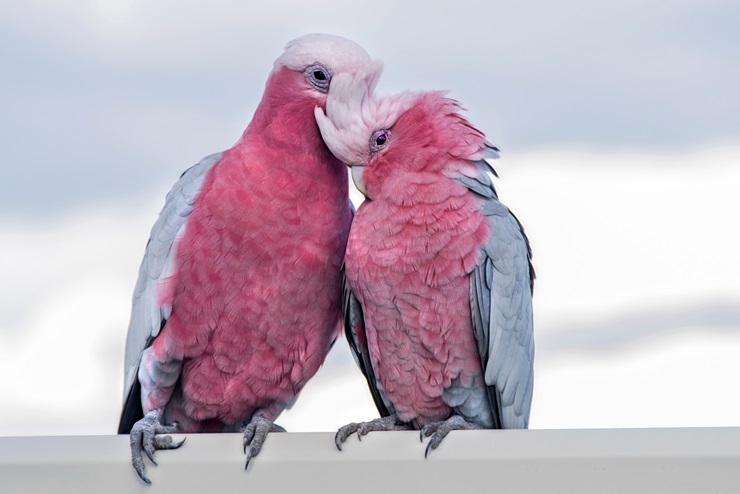
- Scientific Name: Eolophus Roseicapilla
- Size: 14 inches
- Weight: 10 to 12 ounces
- Wingspan: 30 inches
Though much of their body is covered in gray feathers, galahs can be distinguished by their bright pink breast, face, neck, and underparts as well as a light pink crest. Males and females are distinguished by dark brown or blackish and medium brown to red eye irises respectively.
These medium-sized birds can be found all across Australia (even in Tasmania), but galahs do avoid drier regions. As very adaptable birds, galahs can make their homes in bustling cities with a few trees for refuge and deep into tropical forests with plenty of rainfall.
Using nature as protection, galahs like to nest in hollow tree cavities once they have mated. Female galahs will have two to six eggs in their one brood per year.
Galahs have been found in flocks as small as ten birds to as large as one thousand birds of mixed species.
6. Pine Grosbeak
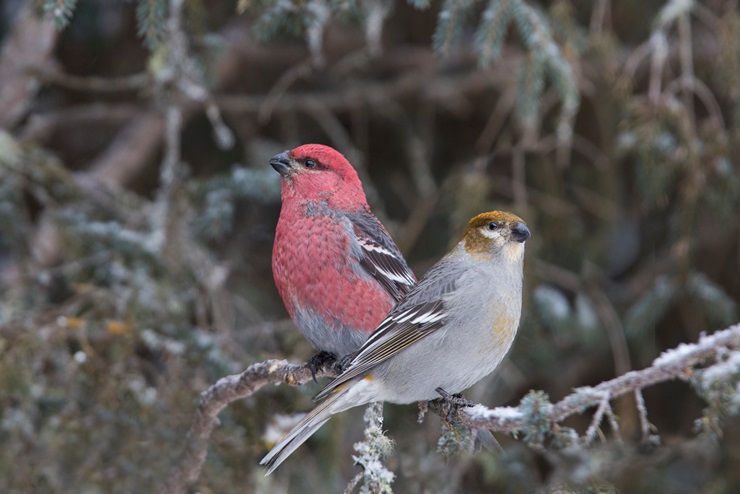
- Scientific Name: Pinicola Enucleator
- Size: 7.9 to 10 inches
- Weight: 1.8 to 2.8 ounces
- Wingspan: 13 inches
Both genders of the pine grosbeak are plump, heavy-chested finches with dark conical bills and primarily rosy-pink-colored bodies. While both have gray wings and tailfeathers with two white wing bars, males have pink heads while females have orange heads and an orange spot above their tails.
Lovers of a chilly climate, pine grosbeaks can be found in Canada, the northern United States, Sweden, Norway, Finland, and southern and central Russia. As their name would suggest pine grosbeaks like to make homes in open pine forests as well as fir and spruce forests.
Pine grosbeaks like to place their bulky cup-shaped nests made of grass, weeds, moss, twigs, rootlets, and lichen on horizontal branches or forks in trees. Females will have two to five clutches in their once-per-year brood.
Due to the tame and slow-moving nature that pine grosbeaks possess, inhabitants of Newfoundland affectionately refer to pine grosbeaks as “mopes”.
7. Pink-Headed Fruit Dove
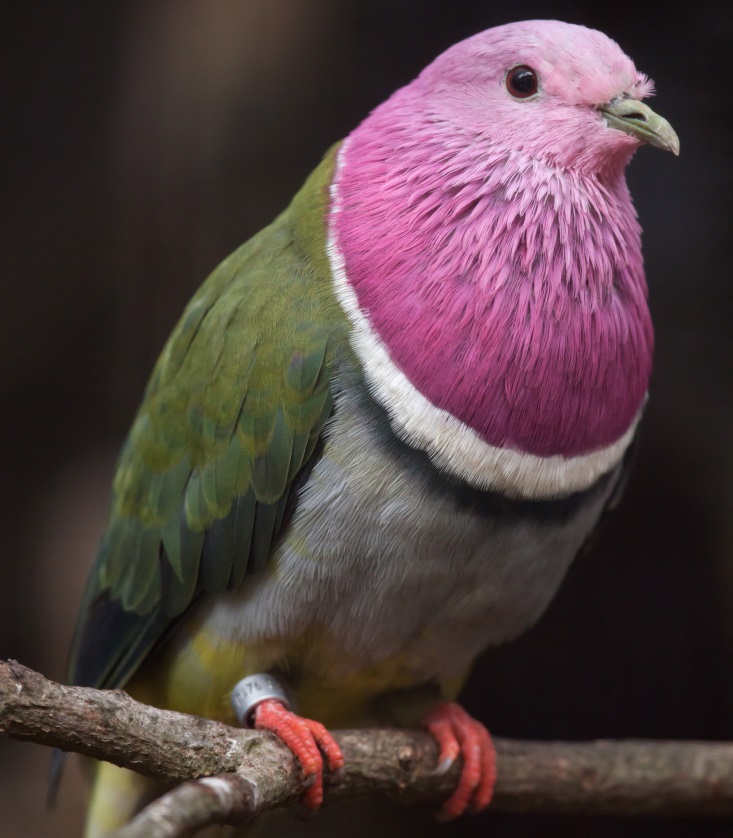
- Scientific Name: Ptilinopus Porphyreus
- Size: 5.9 to 29.5 inches
- Weight: 1 to 70 ounces
- Wingspan: 9.8 to 49.2 inches
As an accurately named bird, the pink-headed fruit dove does have a pink head and chest with a white and black band across its chest, green back feathers, and yellow under tail feathers. Males tend to be more bright while females’ coloration is duller.
These bright birds are located in the islands of southern Indonesia (specifically Sumatra, Bali, and Java). Pink-headed fruit doves are lovers of high altitudes and prefer mountain forests commonly between 621 to 1,242 miles above sea level.
It takes pink-headed fruit doves two to four days to build their cup-shaped nests of twigs. Females will have one to two eggs per brood and can have up to five broods per year.
Despite their bright coloring, pink-headed fruit doves can be difficult to find in even light cover while making noise, which makes it hard for experts to know how big the population is.
8. Pink-Headed Warbler
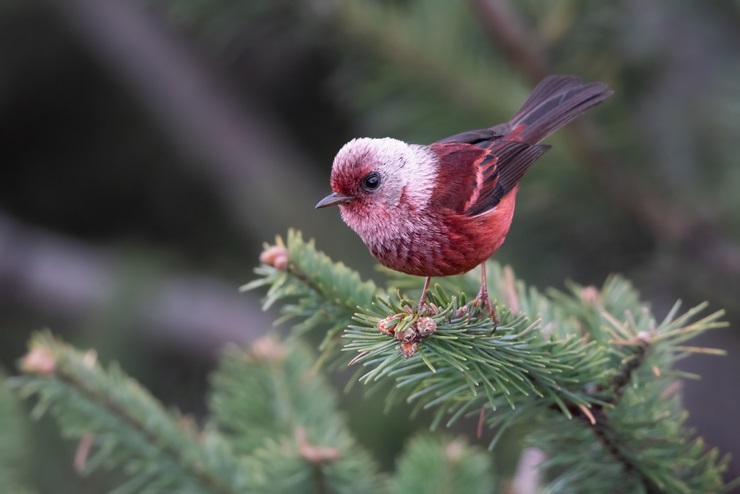
- Scientific Name: Cardellina Versicolor
- Size: 4.9 to 5.3 inches
- Weight: 0.35 ounces
- Wingspan: 7.8 to 8.8 inches
Both male and female pink-headed warblers are predominately reddish-pink with a light pink head and a red spot where their beak connects with their face. They can be distinguished by the vibrancy of colors (females tend to be duller).
Pink-headed warblers like humid to semi-humid forests made of any combination of pine, oak, and evergreen trees in altitudes that are between 5,900 and 11,500 feet above sea level. They can find these places in eastern and central Chiapas and western Guatemala.
The female pink-headed warbler makes the nest by herself when it comes time for her to lay her eggs. She will have two to four clutches per brood with two broods per year.
Since they are not commonly found in flocks larger than two, pink-header warblers stay with their partner year-round.
9. Pink Robin
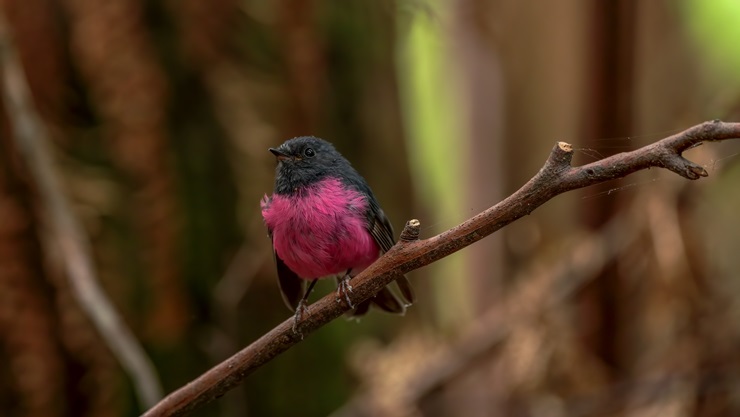
- Scientific Name: Petroica Rodinogaster
- Size: 4.7 to 5.1 inches
- Weight: 0.3 to 0.4 ounces
- Wingspan: 7.5 to 8.5 inches
Male pink robins have blackish-gray heads, backs, necks, wings, and tails with pink breasts that fade to white underparts. Females tend to be pinker and have brown crowns, two beige wing bars, and pink underparts.
Mostly native to southeastern Australia, you can spot pink robins in Tasmania and Victoria but may also see them elsewhere during the warm winters. Pink robins like to have their space, so you may find them in rainforests or grass plains.
A pink robin’s nest is finely made with moss on the inside of the cup shape with spider webs, feathers, or fur used to bind it. Female pink robins will have two broods per year with three to four eggs in each brood.
Pink robins are much quieter than other robin species and only produce a chattering sound (almost like a twig breaking) to communicate with other birds.
10. Roseate Spoonbill
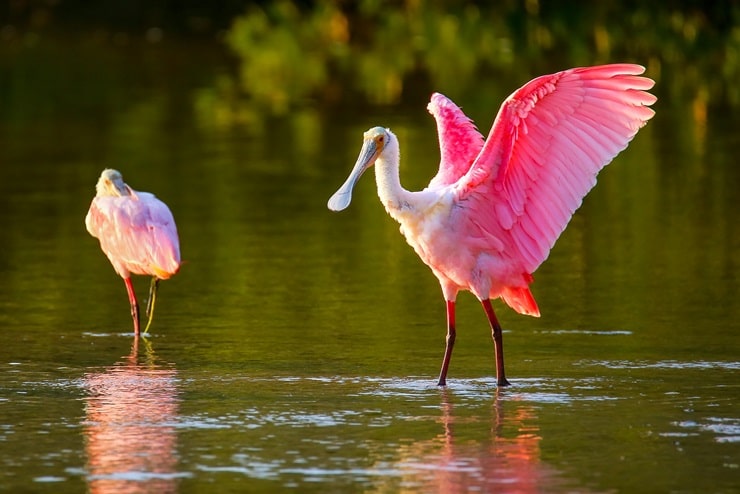
- Scientific Name: Platalea Ajaja
- Size: 27.9 to 33.9 inches
- Weight: 42.3 to 63.5 ounces
- Wingspan: 47.2 to 51.2 inches
Both male and female roseate spoonbills look identical, but females tend to be smaller than males. They are large light pink birds with bright pink on their shoulders and tailfeathers as well as a yellowish-green head.
Mostly native to western South America, roseate spoonbills have been seen in northern South America, the coast of Mexico, the Caribbean, and southern Florida. They choose to make homes near any water source (marshes, swamps, wetlands, etc.) in order to catch their next meal from the water.
Like many birds, the female roseate spoonbills build their nests with materials the males bring them. Females have one brood per year usually consisting of two to three eggs but occasionally with one to five eggs.
Like numerous adults, roseate spoonbills have experience with balding and will lose feathers from the top of their heads as they age.
Other Colorful Birds:
Red Birds
Purple Birds
Green Birds
